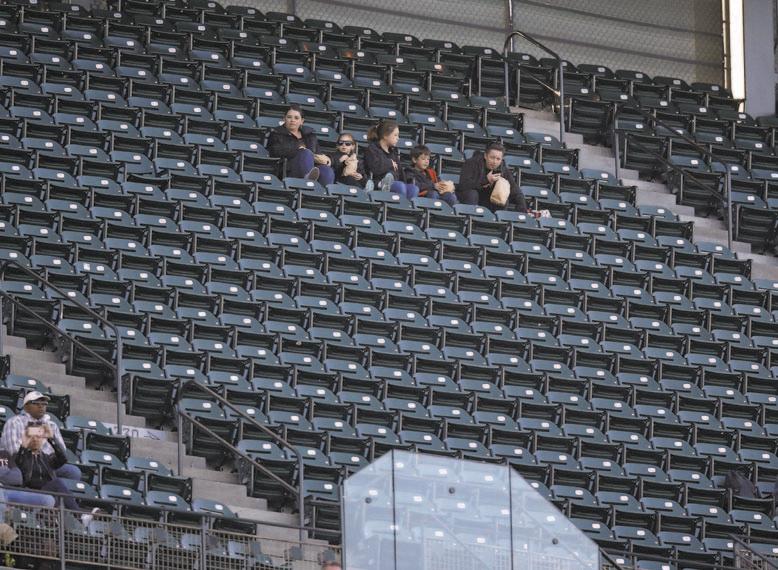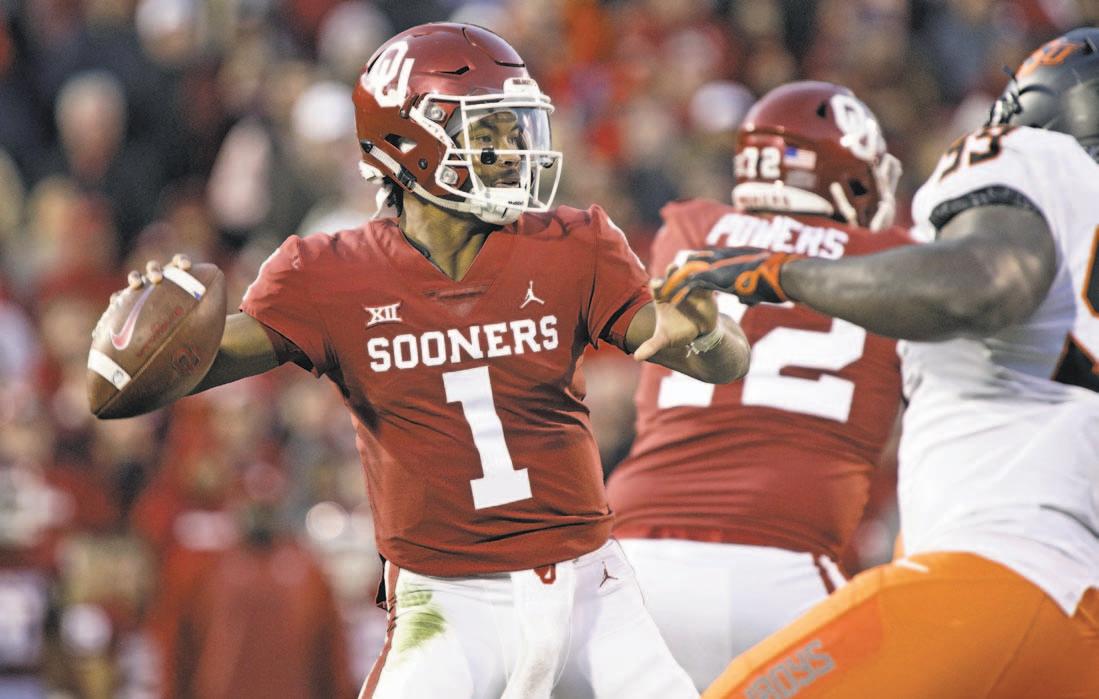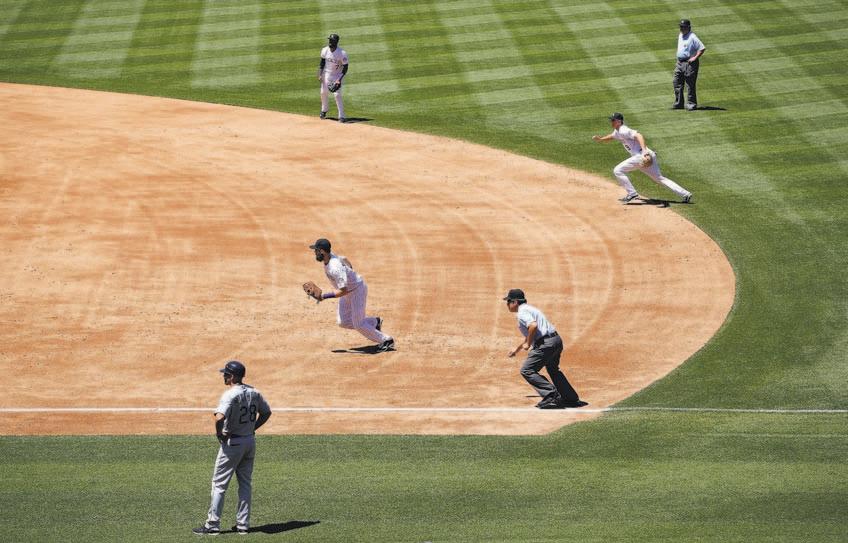
11 minute read
BROKEN, STORY A BASEBALL
Baseball’s flaws have never been more glaring and regularly on display. Luckily, we’re here to help. If Rob Manfred and Co. don’t want to get stiff-armed by the next generation of Kyler Murrays, they better listen up.
STORY BY CARL STEWARD
ILLUSTRATION BY SAM HADLEY
MMajor League Baseball has rightfully approached this season in a panic over its product – and that was before Kyler Murray’s I’m-Off-For-TheNFL scud dropped.

That was a beaning Commissioner Rob Manfred and Co. didn’t need as they were frantically rifling through ideas about pitch clocks, mound heights, the shift epidemic, to DH or not to DH, and teams suddenly using a chorus line of pitchers every game, including starters for no more than an inning or two.

The Grand Old Game is in trouble, despite what purists say, to the point that MLB’s powersthat-be are considering taking a wild whack at any quick-fix notion that’s thrown down the middle at them. Three-batter minimums for pitchers? Good lord. Maybe they should be bringing back Charlie Finley’s old orange baseball idea, too. And the mechanical rabbit. And the jackass.
Baseball may not be dying, but for a sport that seems to be addicted to ridiculous dissection of numbers, put this in your analytics pipe and smoke it: Regular-season attendance dropped a whopping 3 million in 2018 from the previous season.
Perhaps more disturbing, 10 million fewer people showed up at ballparks than did 10 years ago, reflecting a slow but steady decline that can’t be blamed on bad weather, which was one of the official excuses offered by the league offices for last season’s alarming drop-off.

And how does MLB explain October? Baseball got what it supposedly always craves in the postseason – a matchup of traditional big-market powers from opposite coasts in the World Series.
The Boston Red Sox and Los Angeles Dodgers should have killed it ratings-wise. Instead, they got slaughtered. Average per-game ratings were down 23 percent from the 2017 match of the Dodgers and Astros, and an astonishing 38 percent from two years ago when the Cubs beat the Indians.
Why are people so turned off to baseball, whether in-person or from their couch?
The way the game is being played at its highest level today is a lot less compelling than it used to be, and it’s somehow taking a whole lot longer. That’s a 6-4-3 double-negative cue for sports fans of the 21st century to look elsewhere for faster, more action-packed options.
It’s even turning prospective stars like Murray away. Once upon a time, baseball was always the No. 1 pursuit of the best young athletes. Those days are long gone. So is Murray.
So where do we start fixing baseball for the betterment of all? We have a few changeups in our ball bag …
Speed Up The Game At All Costs
Face it, we no longer live in a pastoral age. But even if men were still wearing straw hats and applying mustache wax and women were carrying parasols, they’d be railing at the pace of today’s games. For all the talk of change aimed at speeding things up, 2018 represented the seventh straight year games averaged more than three hours: 3:04, to be exact.
Regular-season attendance dropped in 2018 by a staggering 3 million.
An outfield hangout session? Must be yet another pitching change.
Pitch clocks and limiting mound visits hasn’t been enough. All those pitching changes are gumming up good intentions, not to mention those damned replay decisions from New York. It remains baseball’s No. 1 bugaboo. It’s even worse when people watch most — in the playoffs. There were 33 postseason games played in 2018, and care to guess how many were played under three hours? Answer: One. Somehow, the Braves and Dodgers played a division series game in 2:35. But that was by far the anomaly in a postseason in which 23 of the 33 games slow-roasted for more than 3 hours and 30 minutes.

Eight of those 23 exceeded four hours (and four of those were mere nine-inning games). The Dodgers and Brewers played a 13-inning championship series game that lasted 5:15. And of course, Game 3 of the World Series was a 7-hour, 20-minute PBS miniseries all by itself. Played at Dodger Stadium, it ended at roughly 3:30 a.m. in Boston. Even the Cheers bar was closed.
What’s an ideal game time?
Understanding that realistically, we’re never going back to the subtwo hour era when players left their mitts on the field? Here’s our working slogan: Strive For 2:35. That’s not unreasonable. The average NBA game lasts 2:15 counting its halftime, timeouts, replays and other pauses such as Draymond Green technicals.
Did someone say seven-inning games? It’s been thrown out there, and while it would be a lamentable turn of events, baseball can’t keep rolling out these nightly wagon-train excursions and survive in our instant-thrill culture. The kids (not to mention the granddads) are falling asleep, and if you lose them, Mr. Commissioner, you’ve probably lost for good.
Fight For The Best Athletes
So how can baseball start keeping fleet-footed studs like Murray? Frankly, he just may have been a special case. The best way to have kept him would have been to insist he couldn’t play any more football when he accepted the A’s signing bonus money. Alas, the A’s and MLB weren’t counting on him winning the Heisman, getting to the national title game, and at 5-foot-10, improving his stock into the mid-first round of the NFL Draft. They should have been more selfish and said, “You’re ours now, kid.”
As for those draft-able athletes who may not be as rare as Murray, baseball must consider relaxing its draft pool bonus restrictions dramatically and better support teams who risk pursuing dual-sport stars as the A’s did.
In Murray’s case, injury risks aside, he made the obvious choice once he established his football cred. His free agency clock will start immediately when he joins his NFL team next fall, and aside from franchise tagging, he can be an unrestricted free agent after four seasons. In baseball, it might take him three seasons just to make the big leagues, three more seasons to be eligible for arbitration and yet another three to become a free agent.
Nine years as opposed to four? Easy call for Murray. Besides, if he flops in the NFL, he can always return to baseball. Tougher the other way around. Maybe he’ll be back around the time baseball’s collective bargaining agreement comes up for renewal at the end of 2021, and he can take advantage of wholesale changes, which by that time probably will be essential.
While athletes like Kyler Murray become more difficult to lure, rules have yet to prevent dramatic defensive shifts that startle the senses of traditional baseball fans.


Get The Rules Right
Lowering the mound (as opposed to the ludicrous thought of moving it back) isn’t a bad idea. Major league hitters batted a composite .248 in 2018 (lowest since 1969), hit 520 fewer home runs and recorded more strikeouts than hits for the first time in recorded history.
One suggestion, offered recently by former MVP slugger Dale Murphy, would be to lower it three inches this year and three next year, see how it goes. Sure.
Just do it. It might just save some arms from Tommy John surgery in the process as pitchers are much less likely to hump it up to 100 mph throwing on flatter ground.
Pitchers deserve some sort of bone, though. How about acknowledging the real strike zone, and bringing back the high strike? When he was lord of umpires, longtime executive Sandy Alderson fought for that obsessively, and made progress. But now we’re back to the shoebox strike zone, with hitters gearing their launch-angle swing to hit the low strike … because there is no other strike.
The DH? It appears destined for the National League at some point, but who cares? Nobody plays real “NL ball” anymore. Nobody steals. Nobody strategically bunts. Nobody hits the other way on a hit-and-run. Make the DH uniform in both leagues or don’t have it at all.
For all the folks who abhor the DH but also hate seeing pitchers hit, how about this idea: No DH, and pitchers don’t hit, either. Your batting order is 1-8. Sacrilegious? Come on. Not nearly as cuckoo as deciding extra-inning games by starting a guy at second base. And you’re not lifting pitchers for pinch-hitters, either. Maybe they stick around a little longer, and we don’t get the reliever parade so often. Shifts? Hate ’em. Ditch ’em. But only the really extreme ones, where you can get thrown out by the third baseman from short right field. That’s not baseball, that’s bogusball, and one of the truly awful byproducts of too many analytics. Whether shifting left or right, infielders should not be allowed to move beyond second base from their natural position. Give left-handed hitters a chance.
Enough with “openers” or short-inning starters (SIS-sies, as we call them). God bless Madison Bumgarner for standing up to the inanity of it. It’ll be a sad day in Mudville when a starter who goes five innings is called “Hoss,” but that’s where it’s going right now. There were 42 complete games in baseball in 2018. Over the past four decades, we’ve gone from 1,032 complete games in 1978 to 622 to 302 to 136 to 42 in 10-year increments. By 2028, there may be no such thing as a complete game. Or maybe by 2020. Nine teams didn’t have one last year. Seven more only had one.
Maybe we can live without complete games. But is it too much to ask anymore for a solid six or seven innings from one pitcher? Let’s hope not.
Finally, a general wish, not necessarily a rule: Just play the game right, as Tony La Russa always used to say. For instance, let managers manage. Don’t have analytics guys calling them midgame or plotting out the whole pitching spreadsheet beforehand. This isn’t a Strat-O-Matic tournament. We’re not rolling dice here, or flipping cards or probability charts. It’s a sport, a good one if the geeks leave it alone. It was all too obvious in the Series that Dave Roberts was just a puppet in the L.A. dugout, taking orders from a box of nerds somewhere above. Thankfully, the Dodgers deserved what they got – an analytical butt-whupping.
Now it is baseball fans’ turn to get what they deserve. Give them back the real game, and maybe baseball has a chance. The key will be deciding what the real game is, though. Whatever that turns out to be, can we please get it done in less than 3½ hours?


STORY


Mike Fiers, A’s pitcher, on the general minor league bus ride vibe: “You get a 15-hour bus ride with 25 baseball players, you get some weird conversations and bad smells. I don’t know if I want to throw anyone under the bus, but there’s some weird stuff that goes on.”
Ray Black, Giants reliever, on an NYC detour that added hours to an already long trip from Portland, Maine, to Virginia: “We had to drop off our trainer in Manhattan because he was meeting a guy who needed to get elbow surgery. We’re stuck on a bus in Times Square at 10 o’clock at night, all the lights and noise. We were so mad. It’s already a 14- or 15-hour bus ride, and that made it about 18 or 19 hours. I’m pretty sure that after that bus ride one of my teammates retired. He was contemplating it before, but that bus ride tested your will power to play baseball. You get 19 hours and 35 guys on a bus, it was tough. You’re trying to sleep, we’re all sitting upright trying to play cards for 20 hours straight. That was probably the worst bus trip of the minor leagues.”
Dereck Rodriguez, Giants pitcher, takes the ‘‘worst experience’’ trophy: “In 2013 there was a minor league bus involved in a wrong-way accident where the driver ended up dying. I was on that bus. The Twins, we were on our way up to short-season for Elizabethan, and we were driving up by Jacksonville. There was a car in oncoming traffic, and we went into the median (to avoid it). That wasn’t fun.”

Shaun Anderson, Giants’ top pitching prospect with extra motivation to make his way to the majors: “One time in short-season when I first got drafted, we had a 15-hour bus ride, and we left right after the game. It was like 11 p.m. and we went through the night, and we had to play that next day. I was so tired I don’t think I remember the next four days.”
Equipment Snafus Happen
Pat Venditte, formerly the A’s switch-pitcher, now with the Giants, needs a special six-finger glove: “We had a night game in Oklahoma City, and we packed the luggage truck to go to Colorado because we were flying to Colorado Springs in the morning. Our game ended at 11, and we had a flight at 5 a.m. so rather than pay for our bags to go on the plane, they shipped the truck. So I packed up my gloves and sent them. I get called up for the first time that night, and it’s on the weekend. So there’s no chance of me getting a glove until Monday even if they would have flown there and brought it to me. The only glove I had with me was a glove I hadn’t used yet. So I stuck it in the microwave 12 times for 45-second increments. The logo on the glove is smashed and horrible. I was praying I didn’t get a comebacker that night. I had to pitch in the game but luckily no comebackers.”
LOCATION, LOCATION LOCATION … IT OFTEN SUCKS
Bruce Bochy sleuths out his very first minor league stench: “My first assignment when I signed with the Houston Astros, they said, ‘You’re going to Covington, Virginia.’ I said ‘Covington? Where’s Covington?’ So I look on the map, and I drove there from Melbourne, Fla. I’ll never forget, I was getting close to Covington and I got this really awful smell. I didn’t know if something was in my car that died. I pulled over and opened the trunk. Well, it’s a paper mill town and it just smelled awful. In the middle of the town, all of us were going, ‘Wow, are we going to be able to take this for the next two and a half months?’ But you get used to it. We had a great time, a terrific time playing in the Appalachian League.”
Sean Manaea, A’s pitcher, on being one of the fortunate ones: “There was a hotel we stayed at in High-A that had bed bugs, so we had to move rooms a couple of times and eventually go to a different hotel. The locker rooms being a quarter of the size of big league clubhouses, super small with only like two shower heads. That was kind of rough at times. I was lucky; I know some guys who have had buses break down at like 3 in the morning. Rodriguez, on the quirks of location: “Beloit, Wisconsin, and Clinton, Iowa, were not fun. Then this was my first year in Triple-A and Salt Lake City was not fun. Vegas was not fun. Before I got called up, I had given up like 18 or 19 home runs; it was unbelievable. But half of those home runs I gave up were like pop outs. There were a couple where I thought, ‘No way that’s going out,’ and they did. That’s the PCL I guess.”

DUDE, YOU’RE GETTING PAID TO PLAY BASEBALL
Far left: Jharel Cotton “didn’t mind the minor leagues too much,” despite the bed bugs.
Above, A’s pitcher Sean Manaea says he was lucky, recalling guys who had buses break down in the wee hours.
At left: Giants pitcher Dereck Rodriguez was on a tragic bus trip with the Twins.
Jharel Cotton, A’s pitcher and wise sage: “I had bed bugs in one of my hotels. I didn’t mind the minor leagues too much, though. I kind of overlooked all the bad stuff. Of course, the big leagues is much better, but at the time the minor leagues were all I knew.” gs mi mind nd h ed all










